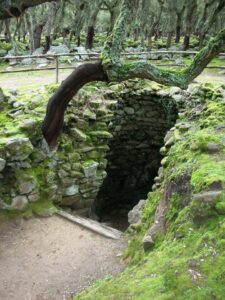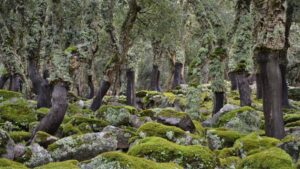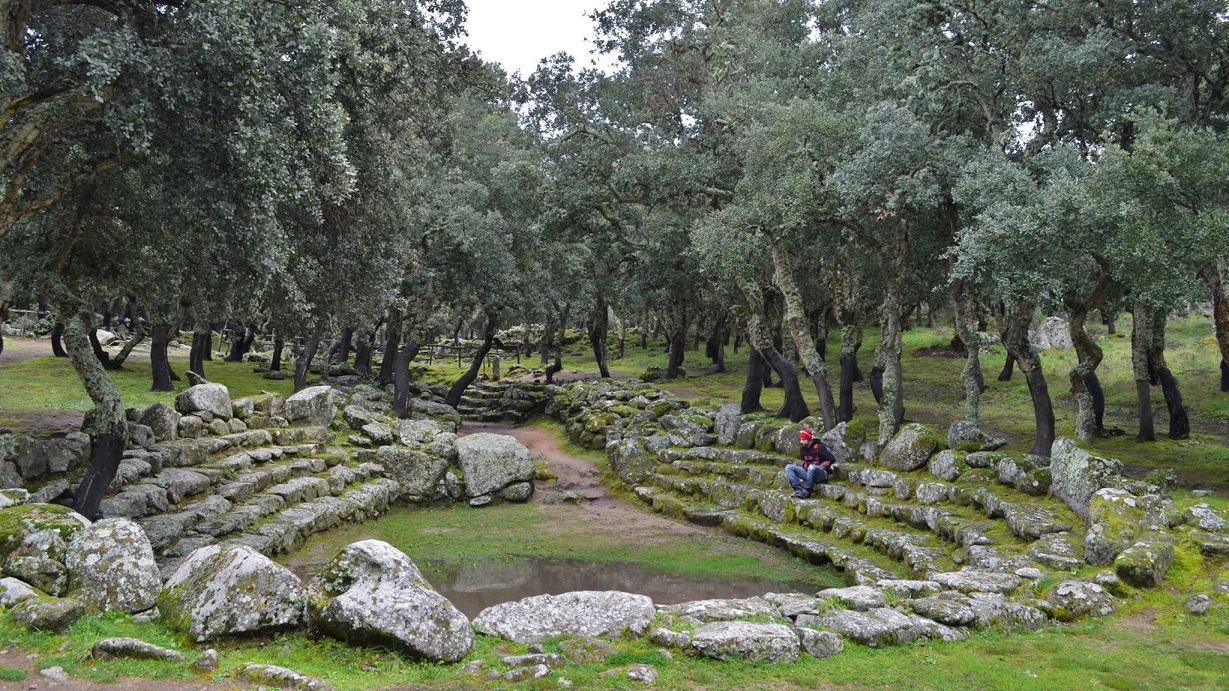“The archaeological complex of Romanzesu is one of the main residential and cult sites of the Nuragic age. It constitutes a Nuragic federal sanctuary, according to the definition coined by the great archaeologist Giovanni Lilliu, meaning a place of worship frequented by village communities even distant from each other. Generally dedicated to the worship of water, these sanctuaries were centered around the presence of sacred buildings of different types (well temples, megaron temples). It is believed that in the main building of the village, the most powerful clans of central Sardinia would gather in federal assemblies to consecrate alliances or to decide wars. The communal structures were organized to allow for moments of religious celebration and civil festivity, the market with the political assembly. The sanctuary village of Romanzesu, which extends over about seven hectares within a dense cork oak forest, includes several structures for worship and around a hundred huts…” (from the Mibact website). This extraordinary archaeological complex, located in the territory of Bitti, is extensively described in a long article by Maria Ausilia Fadda, published in the March-April 2017 edition of “Archeologia Viva.” From this article, we have extracted some explanatory passages:
This extraordinary archaeological complex, located in the territory of Bitti, is extensively described in a long article by Maria Ausilia Fadda, published in the March-April 2017 edition of “Archeologia Viva.” From this article, we have extracted some explanatory passages:
“The birth of the settlement, dating back to the Middle Bronze Age (1500 BC), was favored by an abundant spring, around which, during the Final Bronze Age (1200 BC), the Nuragic people built a well temple dedicated to the water deity.”…”When the water overflowed beyond the highest step of the well, it was made to flow through two small intermediate basins equipped with stepped seats, to be finally channeled into a large semicircular basin always surrounded by steps, which the pilgrims occupied during religious ablutions and to witness the oracular rites. The sacredness of the well was marked by three orthostatic betyls (upright stones) on either side of the entrance.”…”Around the sacred well, several circular huts for residential use with large central hearths and granite seats along the circumference are preserved.”…”During the Final Bronze Age (1200 BC), the village of ‘Romanzesu’ acquired functions as a sanctuary, documented by three ‘megaron’ temples and by a sub-elliptical ceremonial area with the remains of concentric walls that defined a labyrinthine passage for the pilgrims. This passage led to a hut with a paved floor and a circular base in the center, which was meant to support a model of a nuraghe – of strong symbolic value – or other liturgical objects for the priest-shaman.”…”Near the ceremonial area, the ‘megaron’ temple is preserved.”…”In the more peripheral part of the settlement, on land with outcroppings of granite rock, in the final phases of the Bronze Age (1200 BC), the inhabitants of the sanctuary built another small ‘megaron’, also of the double ‘in antis’ type, adapting it to the rugged morphology of the place.
 “The external area was leveled with granite slabs and enclosed by a sacred precinct (temenos) to gather pilgrims…”…”Above the well temple, beneath the dry stone walls of a pasture, a third ‘megaron’ temple was discovered…”…”In the final phases of the Bronze Age (1200-1000 BC), the ‘megaron’ temple underwent changes, perhaps due to transformations in religious rituals inspired by cultural influences from outside Sardinia. The entrance and the short access corridor were closed, and inside the small building transformed into a ‘heroon’ (sacred building dedicated to a hero), over a meter and a half deep, four bronze spearheads, large bronze tips, some small daggers, pins, and fragments of ‘ox-hide’ ingots were buried…”…”The transformation of the ancient temple building into a ‘heroon’ also led to the construction of a second small ‘temenos’, without entrances, corresponding to the short side of the small building. This enclosure preserved a rich votive deposit consisting of small daggers, pins, beads, bracelet bands, bronze pendants, fragments of low-arched and leech brooches, rings, glass paste beads, and fragments of ingots…”…”But the most precious and unique part of the deposit consisted of no less than one hundred thirty-one amber beads. One bead even retains the thread of the necklace. The exceptional finding of amber beads in a Bronze Age sanctuary context, in one of the most inland territories of Sardinia, has sparked great interest, also in order to reconstruct the trade routes that made the arrival of the precious fossil resin in such difficult-to-reach areas possible. The sanctuary of ‘Romanzesu’, despite the importance it had for many centuries, was abandoned around the 7th century BC without noticeable signs of crisis…”.
“The external area was leveled with granite slabs and enclosed by a sacred precinct (temenos) to gather pilgrims…”…”Above the well temple, beneath the dry stone walls of a pasture, a third ‘megaron’ temple was discovered…”…”In the final phases of the Bronze Age (1200-1000 BC), the ‘megaron’ temple underwent changes, perhaps due to transformations in religious rituals inspired by cultural influences from outside Sardinia. The entrance and the short access corridor were closed, and inside the small building transformed into a ‘heroon’ (sacred building dedicated to a hero), over a meter and a half deep, four bronze spearheads, large bronze tips, some small daggers, pins, and fragments of ‘ox-hide’ ingots were buried…”…”The transformation of the ancient temple building into a ‘heroon’ also led to the construction of a second small ‘temenos’, without entrances, corresponding to the short side of the small building. This enclosure preserved a rich votive deposit consisting of small daggers, pins, beads, bracelet bands, bronze pendants, fragments of low-arched and leech brooches, rings, glass paste beads, and fragments of ingots…”…”But the most precious and unique part of the deposit consisted of no less than one hundred thirty-one amber beads. One bead even retains the thread of the necklace. The exceptional finding of amber beads in a Bronze Age sanctuary context, in one of the most inland territories of Sardinia, has sparked great interest, also in order to reconstruct the trade routes that made the arrival of the precious fossil resin in such difficult-to-reach areas possible. The sanctuary of ‘Romanzesu’, despite the importance it had for many centuries, was abandoned around the 7th century BC without noticeable signs of crisis…”. The photos of the sanctuary are by Nicola Barbicha Tornello, Beatrice Auguadro, and Alberto Valdès.
The photos of the sanctuary are by Nicola Barbicha Tornello, Beatrice Auguadro, and Alberto Valdès.

